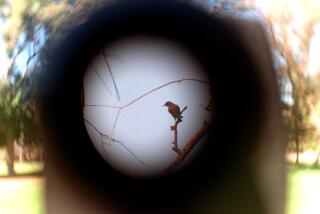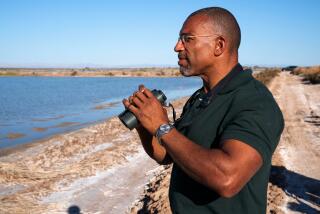Notes about your surroundings.
- Share via
Tools of the Trade--With the fall bird migration already under way--the shore birds are arriving, with land birds due in the coming weeks--would-be bird-watchers might want to think about investing in a set of binoculars, an essential tool for distinguishing the many species that will make an Orange County appearance.
Sylvia Gallagher offers a few tips to students in the birding skills workshops she heads for the local Sea and Sage Chapter of the National Audubon Society. Among them:
* Select a magnification power of 7 to 10; 7 or 8 is adequate for most beginners, she says.
* On binoculars, the magnification is followed by a second number, as in 7x35. This second number, which measures the amount of light reaching the retina, should be between four and five times the first number (the magnification).
* The closest distance at which the binoculars can focus should be no more than 15 feet. Some models offer significantly closer focus than that.
* Eyeglass wearers should look for something called “long eye relief,” which gives a greater field of view to compensate for having the eye farther back from the scope. With some scopes, she says, “it’s like you’re looking through a soda straw, the field is so limited.”
Cost can run more than $1,000. A decent pair of binoculars for a beginner will cost “the better part of $100,” Gallagher says. “You get what you pay for.”
For experienced birders with money to spend, two binocular models are now hot: the 10-power Bausch & Lomb Elite and the Zeiss 10x40B. These “Cadillacs” cost about $800, Gallagher says.
More to Read
Sign up for The Wild
We’ll help you find the best places to hike, bike and run, as well as the perfect silent spots for meditation and yoga.
You may occasionally receive promotional content from the Los Angeles Times.






